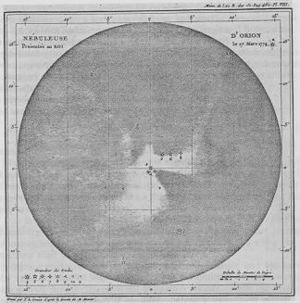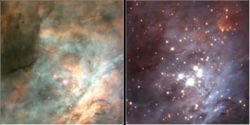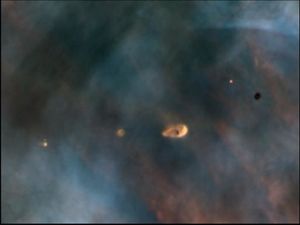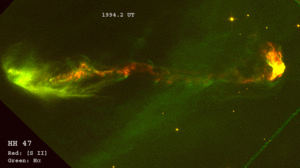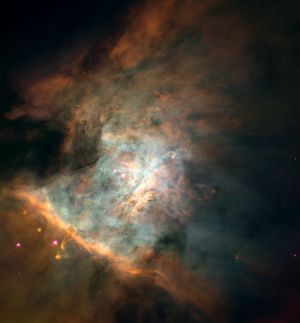الجبار (سديم)
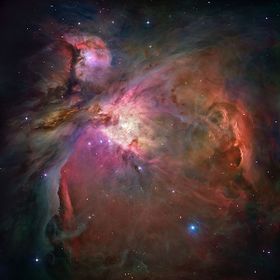
| |
| بيانات المراقبة: حقبة J2000 | |
|---|---|
| النوع: | انعكاس وانبعاث |
| المطلع المستقيم: | 05س 35د 17.3ث[1] |
| الميل الزاوي: | −05° 23′ 28″[1] |
| المسافة: | 1,270±76 س.ض. (389 pc)[2] |
| السطوع الظاهري (V): | +3.0[3] |
| أبعاد ظاهرية (V): | 65×60 arcmins[4] |
| برج: | الجبار |
| الخصائص الطبيعية | |
| القطر: | 12 س.ض.[a] |
| النصوع المطلق (V): | — |
| خصائص هامة: | Trapezium cluster |
| أسماء أخرى: | NGC 1976, M42, LBN 974 |
| انظر أيضاً: سديم انتشاري, قائمة السدائم | |
سديم الجبار Orion Nebula (ويعرف أيضاً باسم مسييه 42, M42, أو NGC 1976) هو سديم انتشاري يقع جنوب[b] حزام الجبار. وهو أحد أشد السدائم بريقاً, ويمكن مشاهدته بالعين المجردة في سماء الليل. M42 يقع على بعد 1,270±76 سنة ضوئية[2] وهو أقرب منطقة ذات تكون نجوم غزير إلى الأرض. سديم الجبار M42 يـُقدر عرضه بنحو 24 سنة ضوئية. النصوص القديمة كثيراً ما أشارت إلي مسديم الجبار باسم السديم الأعظم في الجبار أو سديم الجبار الأعظم. بينما النصوص الأقدم, تشير إليه باسم إنسيس Ensis, وهو أيضاً اسم النجم Eta Orionis.[5]
سديم الجبار Orion Nebula يعتبر أحد أكثر الأجرام السماوية دراسة وتصويراً في سماء الليل, وبين أكثر الظواهر السمائية دراسةً.[6] السديم كشف عن عملية تكون النجوم والمجموعات الكوكبية من انهيار/انضغاط سحب من الغاز والغبار. وقد شاهد الفلكيون مباشرة protoplanetary disks, الأقزام البنية brown dwarf والحركات الشديدة والعاصفة للغازات, وتأثيرات التأين الضوئي للنجوم الهائلة القريبة في السديم.
معلومات عامة
التاريخ
The Maya of Central America had a folk tale which dealt with the Orion constellation's part of the sky, known as Xibalba.[7][بحاجة لمصدر]
البنية
سديم الجبار بكامله يمتد على مساحة 10° من السماء, ويضم سحاب متعادل من الغاز والغبار, associations of stars, ionized volumes of gas و سدائم انعكاسية.
التكوين النجمي
سديم الجبار هو مثال لحضانة نجوم حيث تولد النجوم الجديدة. مراقبة السديم أظهرت تقريباً 700 نجم في مختلف مراحل التكون داخل السديم.
الرياح النجمية وتأثيرها
النشأة
انظر أيضاً
الهامش
- ^ 1,270 × tan( 66′ / 2 ) = 12 ly. radius
- ^ From temperate zones in the Northern Hemisphere, the nebula appears below the Belt of Orion; from temperate zones in the Southern Hemisphere the nebula appears above the Belt.
- ^ C. Robert O'Dell commented about this wikipedia article, "The only egregious error is the last sentence in the Stellar Formation section. It should actually read 'Even though most planetary disks can form planets, observations show that intense stellar radiation should have destroyed any proplyds that formed near the Trapezium group, if the group is as old as the low mass stars in the cluster. Since proplyds are found very close to the Trapezium group, it can be argued that those stars are much younger than the rest of the cluster members.'"
المصادر
- ^ أ ب "SIMBAD Astronomical Database". Results for NGC 7538. Retrieved 2006-10-20.
- ^ أ ب Sandstrom, Karin M (1999). "A Parallactic Distance of 389+24-21 parsecs to the Orion Nebula Cluster from Very Long Baseline Array Observations". The Astrophysical Journal. 667 (2): 1161–1169. Retrieved 2007-11-03.
{{cite journal}}: Unknown parameter|coauthors=ignored (|author=suggested) (help) - ^ "Nasa/Ipac Extragalactic Database". Results for NGC 1976. Retrieved 2006-10-14.
- ^ Revised NGC Data for NGC 1976 per Wolfgang Steinicke's NGC/IC Database Files.
- ^ Allen, Richard Hinchley; Starnames, Their Lore and Meaning, 1889
- ^ Press release, "Astronomers Spot The Great Orion Nebula's Successor", Harvard-Smithsonian Center for Astrophysics, 2006.
- ^ Kaufman, Anthony (2006). "Transcending Death: An interview with Darren Aronofsky, director of The Fountain". seed (November). Retrieved 2007-05-22.
{{cite journal}}: Unknown parameter|month=ignored (help)
وصلات خارجية
- Orion Nebula observed by Chandra/HST
- Orion Nebula observed by Gemini Observatory
- Orion Nebula at ESA/Hubble
- Messier 42, SEDS Messier pages and specifically NGC 1976.
- January 2006 Hubble Space Telescope image of the Orion Nebula
- January 2006 Hubble Space Telescope image of the Trapezium cluster
- Orion Nebula M42, Hubble Images
- Remarkable new views captured of Orion Nebula, SpaceFlight Now, 2001.
- NightSkyInfo.com - The Great Orion Nebula
- Computer visualization of Orion Nebula. Data gathered from the Hubble Space Telescope and ground-based sensors were combined to form a 3D volume visualization of the nebula. Narration of the planetarium-like flythrough describes notable features and views from angles not possible from Earth. Link contains downloadable MPEG and Quicktime movies of flythrough.
